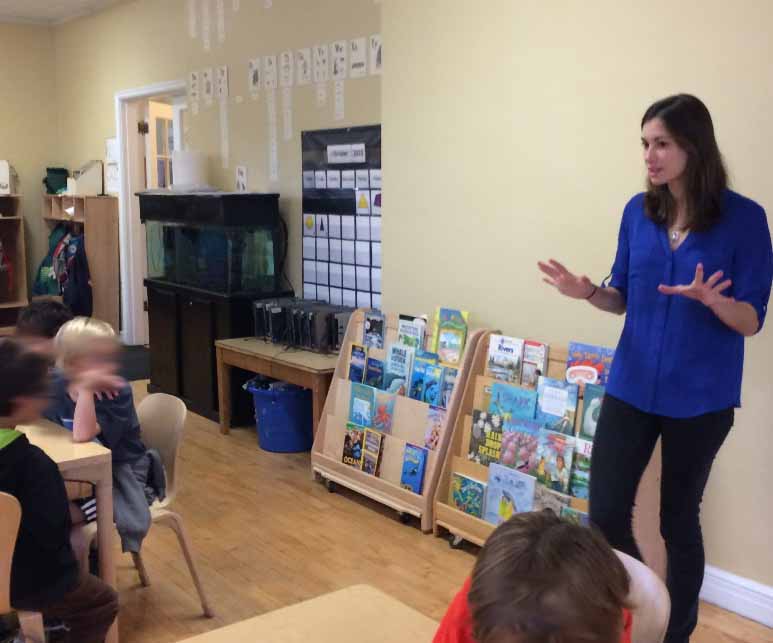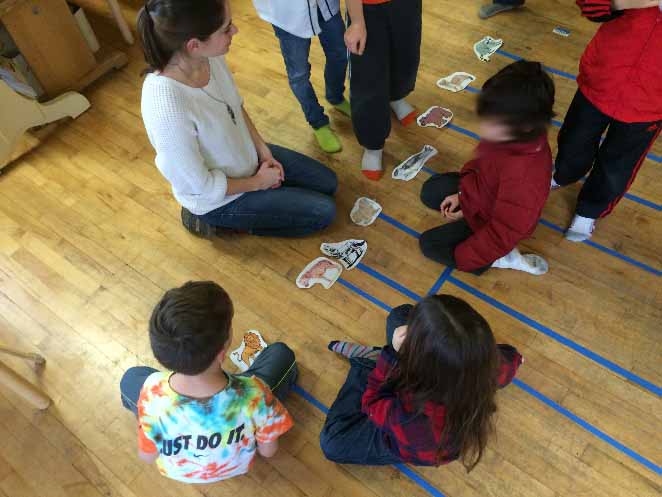Eileen Hynes is a teacher at Lake and Park School in Seattle, Washington. She is a member of NCSE’s teacher advisory board, a National Geographic Teacher Fellow, and a NOAA Climate Steward.
When I first learned about NCSE’s Scientist in the Classroom program, I jumped at the opportunity to be a part of the pilot. Scientists in the Classroom is just the kind of program that we look for at our school, one that creates engaging and meaningful experiences for our students. It was not just a gift to get matched with Mary, a first year graduate student at the University of Washington School of Fisheries, but complete serendipity, as I was about to launch into a major thematic study of the ocean with the teachers and students at Lake and Park School.
 For her first visit, Mary brought the tools of an oceanographer, including her scuba gear, to share. The kids were thrilled to hear about the adventures she had as a marine scientist, from collecting data on a dive to using the latest technology in her genomics lab. The students had recently visited the Cedar River Watershed and were working to understand the hydrologic cycle, the relationship between the oceans and freshwater, and the effects of climate change on the ocean. Mary answered all of their questions about climate change and the ocean, and even brought in a game to illustrate the effects of overfishing on ecosystems and fishing communities.
For her first visit, Mary brought the tools of an oceanographer, including her scuba gear, to share. The kids were thrilled to hear about the adventures she had as a marine scientist, from collecting data on a dive to using the latest technology in her genomics lab. The students had recently visited the Cedar River Watershed and were working to understand the hydrologic cycle, the relationship between the oceans and freshwater, and the effects of climate change on the ocean. Mary answered all of their questions about climate change and the ocean, and even brought in a game to illustrate the effects of overfishing on ecosystems and fishing communities.
After our first visit, we made plans to travel to the University to visit Mary’s lab. During this visit, students learned about fish adaptations, worked with a species identification key, and saw the university's fish collections. At the end of the day, the students played an active game where they “swam” around on the grass looking for genetically similar fish. If that had been all we did with Mary, it would have been plenty—but there was more to come! In November she was back again, joining us on a whale watching expedition in the Salish Sea. On the whale watch, students got to know Mary better. They shared their science journals with her, talked about their observations, and asked her countless questions. In addition to being a scientific expert and role model for the students, Mary was becoming an integral part of our class. Throughout the entire ocean study this fall, Mary helped students practice thinking like scientists. With Mary’s help, students wondered, observed, and experimented to understand adaptations and the effect of climate change on the ocean.
 In December Mary joined us as we marked the end of one year and the beginning of another with the study of deep time and evolution. Through the use of pictures and a large model of the evolutionary tree of Mammalia, students worked in small groups to arrange the animals on their tree. Another group of budding scientists arranged pictures of the different steps of the evolution of whales from the sea to land and back again. This was a thoughtful and concrete presentation that created an effective space for the students to visualize evolution.
In December Mary joined us as we marked the end of one year and the beginning of another with the study of deep time and evolution. Through the use of pictures and a large model of the evolutionary tree of Mammalia, students worked in small groups to arrange the animals on their tree. Another group of budding scientists arranged pictures of the different steps of the evolution of whales from the sea to land and back again. This was a thoughtful and concrete presentation that created an effective space for the students to visualize evolution.
Connecting with Mary has provided Lake and Park School students a wonderful opportunity to see a scientist in action and learn about evolution and climate change from someone in the thick of it. In fact, it was such a great experience that we’ll be working with Mary this spring, even as she travels to South Korea for the World Fisheries Conference (we’ll be Skypeing her in!). Inviting a scientist into the classroom is such a simple thing, but the impact on my students has been enormous. What will we do with Mary this spring? Stay tuned!
